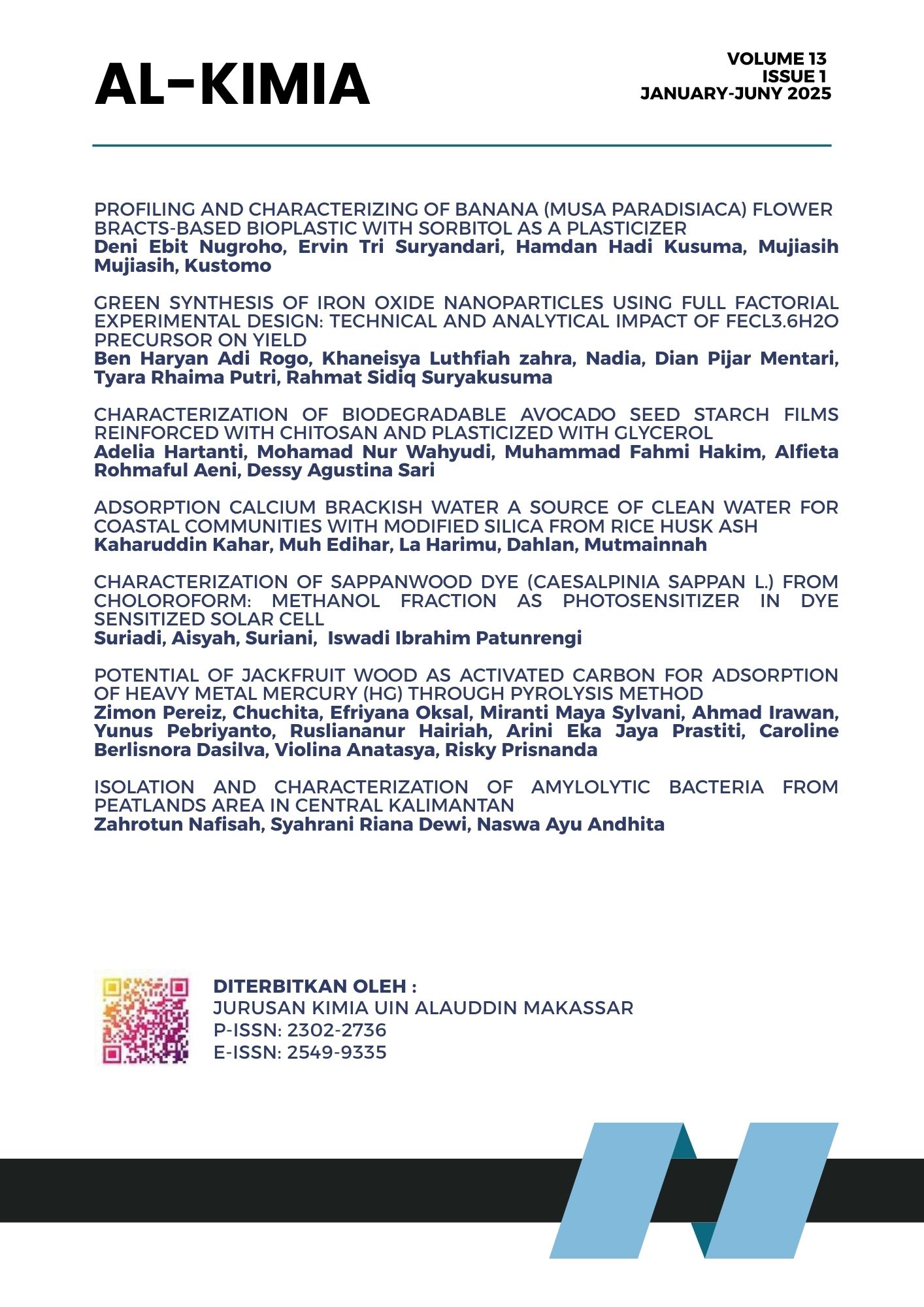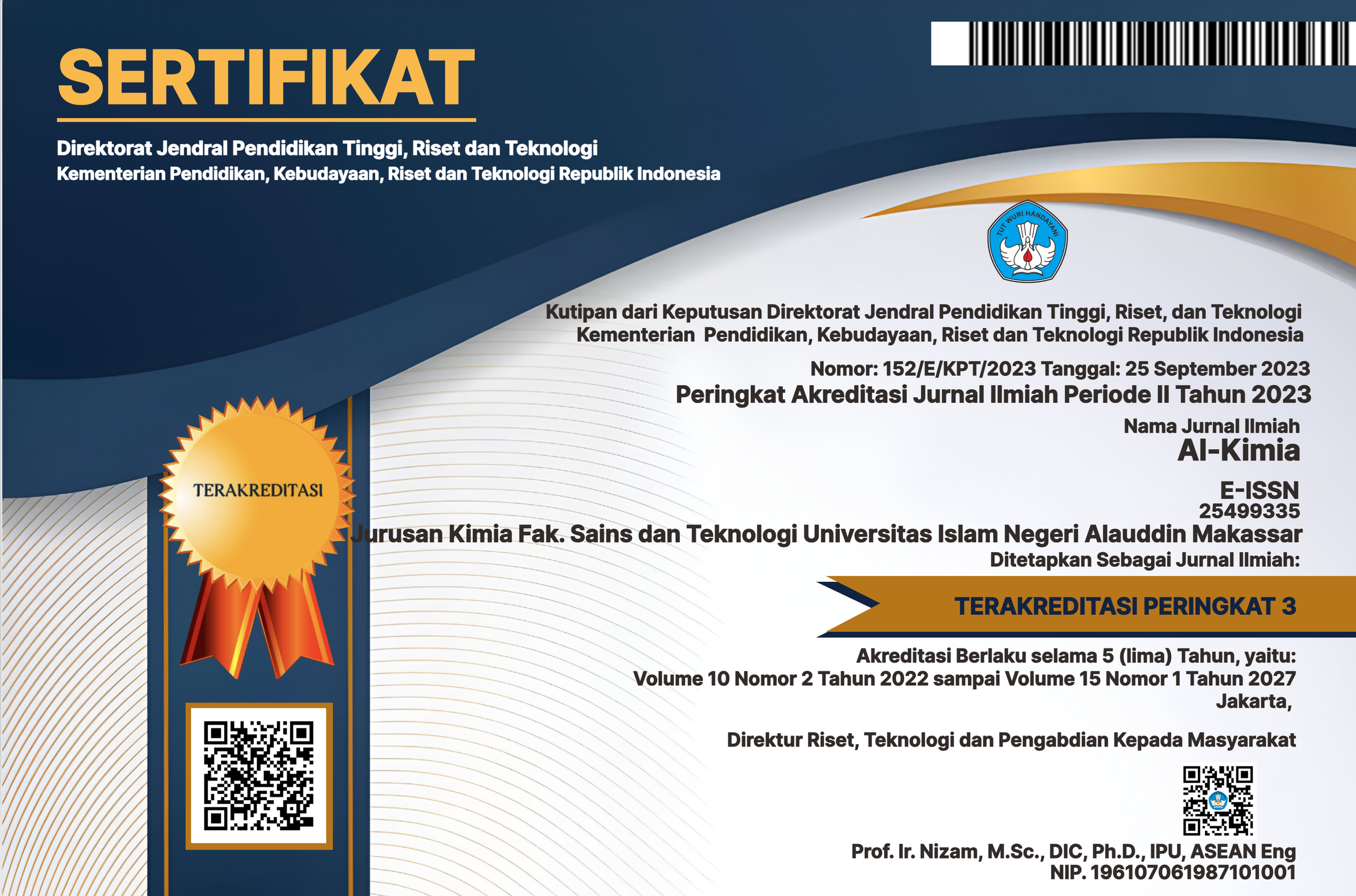A Green Synthesis of Iron Oxide Nanoparticles Using Full Factorial Experimental Design: Technical and Analytical Impact of FeCl3.6H2O Precursor on Yield
Keywords:
ANOVA, Full factorial, IONPs, Pro-analytical, TechnicalAbstract
Green synthesis of iron oxide nanoparticles (IONPs) has emerged as an eco-friendly alternative to conventional synthesis methods. This method utilizes natural ingredients, such as green tea extract, as a reducing agent that supports the green chemistry process. This research aims to analyze the effects of precursor concentration, reducing agent volume, and reaction temperature on
the synthesis results using technical and pro-analytical FeCl3.6H2O precursors. A full factorial design was employed to assess the effect of synthesis conditions on the IONPs yield. The yield was statistically analyzed using analysis of variance (ANOVA). The analysis results reveal that the predicted values are within reasonable consistency based on the experimental data of both IONPs from the technical
and pro-analytical precursors. The ANOVA values for both precursor sources show that the reaction temperature factor is negatively correlated, while the precursor concentration and reducing agent volume positively correlate with the IONPs yield. Regression model variance (ANOVA) can be explained 98.15% for the technical precursor model and 99.83% for the analytical precursor model
from data variations. This research can determine the optimal combination of synthesis factors that provide a basis for selecting a synthesis strategy tailored to specific performance requirements. These findings can support the wider application and reproducibility of green synthesis methods in various research contexts and implications for industry.
Downloads
References
Adamu, A., Meller, G. B., & Buhari, S. A. (2020). Evaluation of Full Factorial and Multiple Regression Methods in 33 Factorial Design. Bima Journal of Science and Technology (2536-6041), 3(2), 134–146.
Ahmad, M. M., Aziz, A., Azoddien, M., Khusairi, A., Zahari, M., Nizam, M., & Seman, A. (2016). Application Of Factorial Design To The Stress Phenomenon Of Bacillus Cereus (Atcc 14579). Australian Journal of Basic and Applied Sciences, 10(17), 148–156. http://creativecommons.org/licenses/by/4.0/.
Ajinkya, N., Yu, X., Kaithal, P., Luo, H., Somani, P., & Ramakrishna, S. (2020). Magnetic iron oxide nanoparticle (IONP) synthesis to applications: Present and future. In Materials. 13(20), 4644. https://doi.org/10.3390/ma13204644.
Akhbari, M., Hajiaghaee, R., Ghafarzadegan, R., Hamedi, S., & Yaghoobi, M. (2019). Process optimization for green synthesis of zero-valent iron nanoparticles using Mentha piperita. IET Nanobiotechnology, 13(2), 160–169. https://doi.org/10.1049/iet-nbt.2018.5040.
Altammar, K. A., (2023). A review on nanoparticles: characteristics, synthesis, applications, and challenges. Frontiers in Microbiology, 14(1155622), 1–20. https://doi.org/10.3389/fmicb.2023.1155622.
Anchan, S., Pai, S., Sridevi, H., Varadavenkatesan, T., Vinayagam, R., & Selvaraj, R. (2019). Biogenic synthesis of ferric oxide nanoparticles using the leaf extract of Peltophorum pterocarpum and their catalytic dye degradation potential. Biocatal Agric Biotechnol, 20,101251.
Arsalani, S., Guidelli, E. J., Araujo, J. F. D. F., Bruno, A. C., & Baffa, O. (2018). Green Synthesis and Surface Modification of Iron Oxide Nanoparticles with Enhanced Magnetization Using Natural Rubber Latex. ACS Sustainable Chemistry and Engineering, 6(11), 13756–13765. https://doi.org/10.1021/acssuschemeng.8b01689.
Badr, N. B. E., Al-Qahtani, K. M., & Mahmoud, A. E. D. (2020). Factorial experimental design for optimizing selenium sorption on Cyperus laevigatus biomass and green-synthesized nano-silver. Alexandria Engineering Journal, 59(6), 5219–5229. https://doi.org/10.1016/j.aej.2020.09.051.
Bindes, M. M. M., Cardoso, V. L., Reis, M. H. M., & Buffito, D. C. (2019). Maximisation of the polyphenols extraction yield from green tea leaves and sequential clarification. Journal of Food Engineering, 241, 97-104
Chicco, D., Warrens, M. J., & Jurman, G. (2021). The coefficient of determination R-squared is more informative than SMAPE, MAE, MAPE, MSE and RMSE in regression analysis evaluation. PeerJ Computer Science, 7(e623), 1–24. https://doi.org/10.7717/PEERJ-CS.623.
Dewanto, H. A., Sasongko, A., Qulub, F., Triana, Y., & Parmita, A. W. Y. P. (2023). Studi Pengaruh Temperatur Kalsinasi dalam Pembentukan Nanomagnetite dengan Metode Green Synthesis Ekstrak Daun Nanas. SPECTA Journal of Technology, 7(2), 584–592. https://doi.org/10.35718/specta.v7i2.940.
Enis, I. Y., Sezgin, H., & Sadikoglu, T. G. (2018). Full factorial experimental design for mechanical properties of electrospun vascular grafts. Journal of Industrial Textiles, 47(6), 1378–1391. https://doi.org/10.1177/1528083717690614.
Ghafarzadegan, R., Yaghoobi, M., Momtaz, S., Ashouri, N., Ghiaci-Yekta, M., & Hajiaghaee, R. (2022). Process optimization for green synthesis of iron nanoparticles by extract of fenugreek (Trigonella foenum-graecum L.) seeds. Journal of Medicinal Plants, 21(81), 22–32. https://doi.org/10.52547/jmp.21.81.22.
Gottimukkala, K., Reddy, H. P., & Zamere, D. (2017). Green Synthesis of Iron Nanoparticles Using Green Tea leaves Extract. Journal of Nanomedicine & Biotherapeutic Discovery, 7(1), 1000151. https://doi.org/10.4172/2155-983x.1000151.
Groiss, S., Selvaraj, R., Varadavenkatesan, T., & Vinayagam, R. (2017). Structural characterization, antibacterial and catalytic efect of iron oxide nanoparticles synthesised using the leaf extract of Cynometra ramifora. J Mol Struct, 1128, 572–578. https://doi.org/10.1016/j.molstruc.2016.09.031.
Herlekar, M., & Barve, S. (2015). Optimization of microwave assisted green synthesis protocol for iron oxide nanoparticles and its application for simultaneous removal of multiple pollutants from domestic sewage. International Journal of Advanced Research, 3(4), 331–345.
Jamzad, M., & Bidkorpeh, K. M. (2020). Green synthesis of iron oxide nanoparticles by the aqueous extract of Laurus nobilis L. leaves and evaluation of the antimicrobial activity. Journal of Nanostructure in Chemistry, 10(3), 193–201. https://doi.org/10.1007/s40097-020-00341-1.
Downloads
Published
Versions
- 2025-07-30 (3)
- 2025-07-30 (2)
- 2025-06-29 (1)
How to Cite
Issue
Section
License
Authors who publish with this journal agree to the following terms:
1) Authors retain copyright and grant the journal right of first publication with the work simultaneously licensed under a Creative Commons Attribution License that allows others to share the work with an acknowledgement of the work's authorship and initial publication in this journal.
2) Authors are able to enter into separate, additional contractual arrangements for the non-exclusive distribution of the journal's published version of the work (e.g., post it to an institutional repository or publish it in a book), with an acknowledgement of its initial publication in this journal.
3)Authors are permitted and encouraged to post their work online (e.g., in institutional repositories or on their website) prior to and during the submission process, as it can lead to productive exchanges, as well as earlier and greater citation of published work (See The Effect of Open Access).



